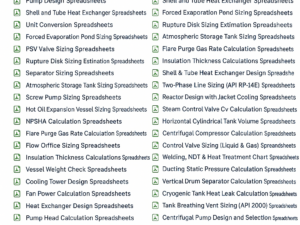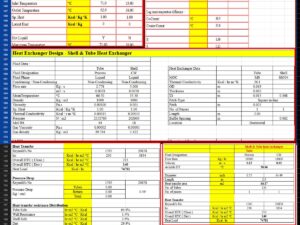A heat exchanger is a device used to transfer thermal energy between two or more fluids at different temperatures. The design of a heat exchanger is crucial for ensuring efficient heat transfer, minimal energy loss, and cost-effectiveness. Key factors influencing the design include the type of heat exchanger, fluid properties, flow arrangement, and thermal requirements.
- Shell and Tube Heat Exchanger – Suitable for high-pressure applications, consisting of tubes enclosed in a shell.
- Plate Heat Exchanger – Uses metal plates to transfer heat, ideal for low-viscosity fluids.
- Double-Pipe Heat Exchanger – Simple design with one pipe inside another, used for small-scale applications.
- Air-Cooled Heat Exchanger – Uses air as a cooling medium, common in power plants.
Design Considerations
- Heat Transfer Rate: Calculated using the formula Q=U⋅A⋅ΔTmQ=U⋅A⋅ΔTm, where UU is the overall heat transfer coefficient, AA is the surface area, and ΔTmΔTm is the log mean temperature difference (LMTD).
- Flow Arrangement: Parallel, counter-flow, or cross-flow configurations affect efficiency. Counter-flow is most efficient.
- Material Selection: Must withstand temperature, pressure, and corrosion (e.g., stainless steel, copper, or titanium).
- Pressure Drop: Excessive pressure drop increases pumping costs, requiring optimization.
- Fouling Factor: Accounts for deposits on surfaces, reducing efficiency over time.
Steps in Design
- Define Thermal Requirements – Heat duty, inlet/outlet temperatures.
- Select Heat Exchanger Type – Based on application and fluid properties.
- Calculate LMTD & Heat Transfer Area – Ensures sufficient heat exchange.
- Determine Pressure Drop – Optimize for energy efficiency.
- Mechanical Design – Ensure structural integrity under operating conditions.
Conclusion
An efficient heat exchanger design balances thermal performance, cost, and durability. Proper selection of type, materials, and flow configuration ensures optimal operation in industries like chemical processing, power generation, and HVAC systems. Advanced software tools (e.g., HTRI, Aspen EDR) aid in precise design and simulation.
 DESING OF HEAT EXCHANGER
DESING OF HEAT EXCHANGER Sale!
Sale!
 Sale!
Sale!
 Sale!
Sale!
 Sale!
Sale!


 DESING OF HEAT EXCHANGER
DESING OF HEAT EXCHANGER